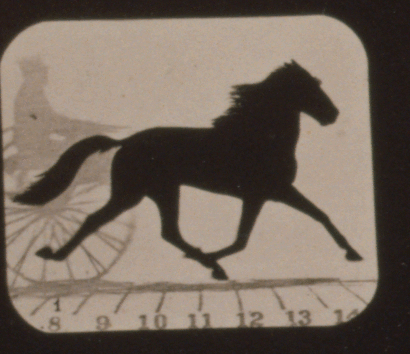
Clay (Fred Low by St. Clair x Maid of Clay by Henry Clay) driven by Charles Marvin. From photo frames by Muybridge.
Another of Stanford’s Morgan racers was a little black inbred Morgan gelding called Clay. He was a son of Fred Low (St. Clair x Lady Ross by Henry Clay). Even though these ancient photo frames are somewhat primitive compared to today’s technology, it is still possible to compare the gait and motion of different horses, and to see clear evidence of Morgan type.
-
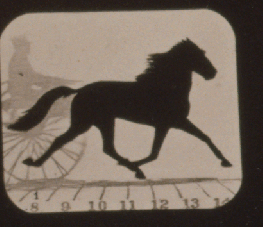
-
Clay
-
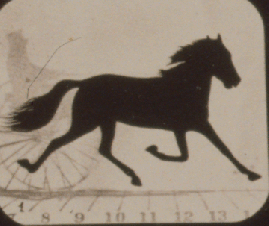
-
Elaine
-
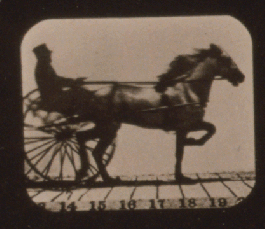
-
Abe Edgington
-
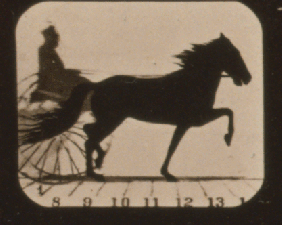
-
Occident
Fred Low, the sire of Clay, was also known as St. Clair 2d, was a brown stallion bred by George Ingles of Sacramento, CA, and foaled in 1864. He was named after Fred Low, the 9th California Governor, who followed Leland Stanford. Considered one of the best sons of old St. Clair, he won first premium at the California State Fair in 1865, 1870, and 1870. St. Clair was lost in a stable fire later the same summer Fred Low was foaled. St. Clair, as we have mentioned, was one of the first Morgans brought to California, and was brought across the plains in 1849 in the lead of a yoke of oxen.
St. Clair was described as “Very dark brown, nearly black, tan-colored flanks, little white on inside of left hind foot, coat fine with small white hairs through it, 151/2 hands, 1015 pounds, very strong and well-muscled, compactly built, wide between the eyes, deep through chest, withers well up, had long and heavy mane and tail and as good legs and feet as ever were on a horse ; would nip the groom sometimes, but of a very intelligent and generally kind disposition” American Morgan Horse Register, Vol I.He was foaled about 1843 in Illinois, and supposed to have been by a son of Barden Morgan, or perhaps by Barden Morgan himself. Although the pedigree of his dam was lost, she also was pure Morgan on both sides of her pedigree.
Barden Morgan, foaled in Vermont in 1826, was considered to be one of the very best representatives of the Morgan family. He was a son of Cock of the Rock by Sherman Morgan, and his dam was a daughter of the original Justin Morgan horse. Cock of the Rock’s dam was also a daughter of Justin Morgan. Thus, Barden Morgan, although a great grandson of old Justin, carried 50% of his blood, so this was a very potent strain. Barden Morgan was a very dark chestnut marked with three white feet, and a narrow stripe in the face. His heavy, waving mane hung to his knees, and his equally thick and luxurious tail hung to the ground. It was said that his style and action surpassed either Hale’s Green Mountain Morgan or his sire old Gifford , who were considered the gold standard in that regard. Barden Morgan was a square trotter with considerable speed, but could also pace rapidly. He had been raced in Vermont and trotted in 2:38 on the ice, a remarkable record for those days.
-
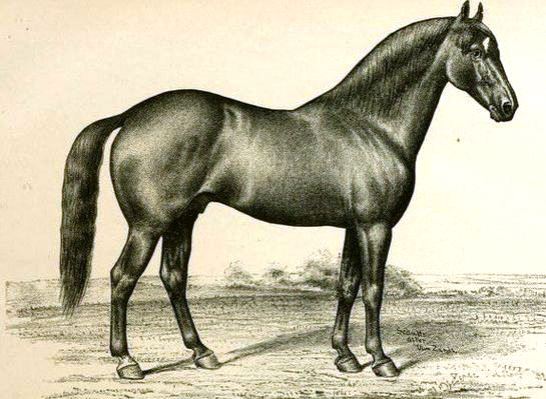
-
Henry Clay (Andrew Jackson x Lady Surrey by Revenge, son of Justin Morgan; 2d dam by True Briton, sire of Justin Morgan. Famous trotting sire foaled 1837. U.S. Public Domain.
The dam of Fred Low was Lady Ross, believed to be the same Lady Ross who was a daughter of Vergennes Black Hawk #1409 by old Black Hawk #20, and her dam by Neave’s Cassius M. Clay Jr #2148. The second dam of Cassius M Clay Jr was a daughter of Engineer 2d, son of Engineer by Justin Morgan. This mare had a record of 2:29 3/4.
The gelding Clay by Fred Low was out of Maid of Clay, a daughter of old Henry Clay #53 whose dam was the well known Lady Surrey, a daughter of Revenge by Justin Morgan, and her dam a half sister of old Justin by his sire, True Briton. Clay was a small horse, according to Charles Marvin, the trainer, and scarcely weighed more than 710 pounds. He would have been very fast but was given too much sharp work against the watch and became an inveterate puller. However, he won a few races for Stanford’s stables, and made an official record of 2:25 1/2.
-
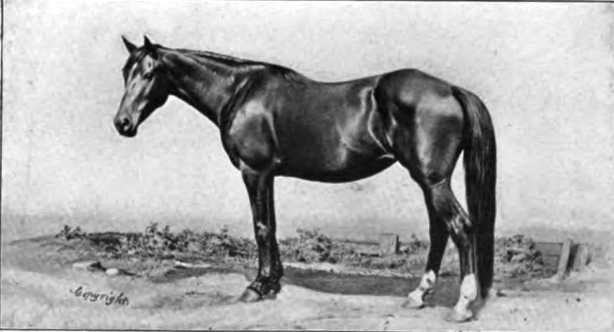
-
Green Mountain Maid (Harry Clay x Shanghai Mary) U.S. Public Domain
Just before hiring Marvin, Leland Stanford had made a visit to the famous Stony Ford Stud of Charles Backman in Orange County New York, the greatest breeder of trotting horses at that time to choose a stallion and several mares to take back to Palo Alto. Among these, he selected the stallion Electioneer, a son of Hambletonian, for which he paid $12,500, and the mare Elaine, a three-quarter sister of Electioneer, sired by Messenger Duroc, for which he paid $7,000. Leland’s purchase of the eight-year-old stallion Electioneer, who was untrained and had sired no offspring of note among the 30 foals he produced for Backman, was not a popular decision among his colleagues, who had expected him to choose Messenger Duroc instead. Leland explained his philosophy for choosing or breeding a horse, “I look at the head first,” he said, “then the form and then the pedigree. I may accept an animal which according to general views is not of good breeding if the other qualities are possessed, but deficiencies in form, or a head that denotes a lack of intelligence, are inseparable barriers in my estimation.” His keen and penetrating vision saw in Electioneer what others did not.
Both Electioneer and Elaine, the cream of his purchase, were out of Green Mountain Maid (Harry Clay x Shanghai Mary), who would be recognized in time as Backman’s greatest broodmare. A granddaughter of Neave’s Cassius Clay Jr. #2148 and out of the mysterious mare Shanghai Mary, Green Mountain Maid would have been eligible for Morgan registry, but spent all her days at Stony Ford and died there, delivering her 17th foal. In 1881, Stanford offered Mr. Backman $10,000 for this exceptional mare, at which time she was 20 years old and Backman had already earned more than $46,000 from the sale of her foals and he still had seven of them left. Backman refused. It seemed a generous offer for an aged broodmare, but by the time Green Mountain Maid died in 1888, Backman had earned almost $69,000 for her foals and he still had not sold them all. When the famous mare died, Backman erected an ostentatious 25 foot high granite monument over her grave, which overlooks the Walkill River, and lists the names of all of her foals and their records. It is still there, and in fact, Stony Ford is still an operational horse farm, although today it is known for breelding champion reining horses.
As Green Mountain Maid had become so valuable, there was considerable interest in tracing her dam. About 1840, Goldsmith Coffein of Red Lion, Ohio, bred a chestnut horse with four white legs, sired by the thoroughbred stallion American Eclipse, and sold half interest to his business partner, John Irons . The horse became known as Iron’s Cadmus and took his color from his dam, a sorrel pacing mare with four white legs, said to be by Brunswick, thoroughbred grandson of Sir Archy, and out of a sorrel, white-legged daughter of Copperbottom by Justin Morgan. In 1850, Mr. Coffein had a promising three-year old filly by Iron’s Cadmus, sorrel with white face and legs like her sire and like his dam and granddam. Her tail had been chewed off by calves. Sometime that summer, he had a serious argument with his son Thaddeus, and the young man disappeared, taking this filly with him in payment for money he said his father owed him for jockey services performed. He was never heard from again, however, some months later some sheepherders met a young man on the road near Canton, Ohio, riding a weary and footsore young sorrel mare with white face and feet, and her tail apparently chewed off by calves. He claimed to have ridden more than 200 miles and traded his mare to them. This mare came to be known as Shanghai Mary. She later proved to be quite fast, and was eventually recognized as bearing a striking resemblance to another daughter of Iron’s Cadmus foaled the same year, the famous pacing mare Pocahontas, even to her pacing conformation. When the matter was researched, although the evidence was circumstantial, it was almost certain that the missing Coffein mare and Shanghai Mary, the dam of Green Mountain Maid, were one and the same.
-
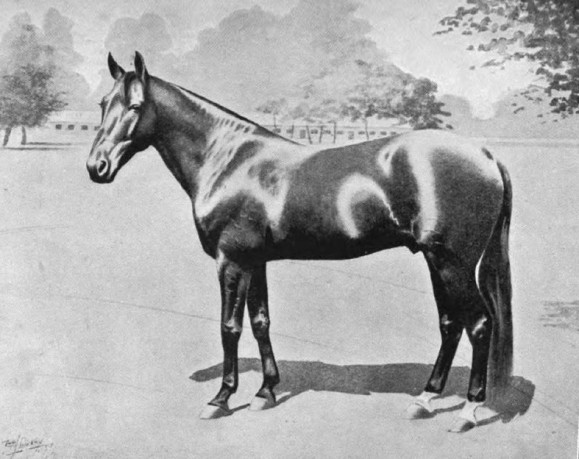
-
Electioneer, from The Horse of America by Wallace, 1897
In all, Stanford had purchased one stallion and a dozen mares, but the only two which proved valuable were Electioneer and his three-quarter sister Elaine, both foals of Green Mountain Maid. Elaine was campaigned and made a record of 2:20 straightaway. And, when Electioneer’s first crop produced Fred Crocker (x Melinche by old St. Clair), who set a new 2 year old record of 2:25 3/4 in 1880, his fame as a sire was assured. His 1881 crop produced the outstanding filly Hinda Rose out of the great broodmare Beautiful Bells (The Moor x Belle of Wabash) Hinda Rose made a yearling record of 2:36 1/2 and lowered the three year old record to 2:19 1/2. Stanford did not care for the pacing gait and insisted that all his horses be taught to trot. By the time Electioneer died in 1890, his offspring held nearly every significant world in existence, and the year after his death, 1891, which was the last year of the high wheeled sulky era, he became the first sire to produce 100 standard performers. The Electioneer sireline is in fact one of four surviving sirelines which remain in the Standardbred breed, but now the they are all pacers, pointing back in time to the pacing cross from Shanghai Mary, which in turn led back to Copperbottom, pacing son of Justin Morgan.
Meanwhile, the photographic experiments with Eadweard Muybridge were drawing to a close. Stanford was fascinated with the study of gait, and Abe Edgington continued to be a popular subject of these sessions, as he was photographed at different gaits, both in harness and under saddle. Muybridge even photographed young Leland Stanford Jr. riding his pony Gypsy. Stanford, having proved his point with the photographs, hired Dr. J.D.B. Stillman to help him prepare a book analyzing the subject of motion in horses.
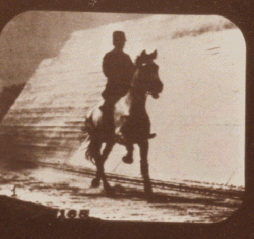
- Abe Edgington performs a circle under saddle. Photo frames by Muybridge.
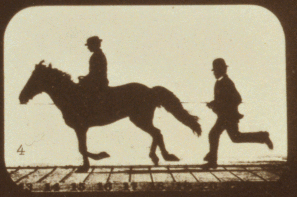
- Leland Stanford Jr , 10 yrs old, riding his pony Gypsy, 1879, photo frames by Muybridge
It was published in 1882 and titled, “THE HORSE IN MOTION, As Shown by Instantaneous Photography With A Study on Animal Mechanics Founded on Anatomy and the Revelations of the Camera In Which is Demonstrated the Theory of Quadrupedal Locomotion. By J.D. B. Stillman, A.M., M.D., Executed and Published Under the Auspices of Leland Stanford.” Muybridge by this time had come to feel the idea of studying motion in horses was his own, and it did spur him on to more photographic experiments in which he examined the motion of humans performing various tasks, as well as the motion of different animals. He quite forgot that the idea had originally been Stanford’s and he had been originally quite skeptical. He forgot also that Stanford had financed the whole thing, providing the most expensive camera equipment, which he allowed Muybridge to keep, and enlisting the help of his railroad engineers to make the experiments possible, and providing the horses which were used as models. Muybridge had been aware that Stanford was preparing a book, but was expecting it to be handsomely illustrated with his own photographs and himself receiving a lion’s share of the credit for the work. When the book came out, Muybridge was shocked to find he was not mentioned on the title page at all, and was barely mentioned in the Preface as being “a very skillful photographer” which Stanford had employed. Moreover, very few of Muybridge’s photos were used in the book, and a majority of the illustrations were line drawings.
Muybridge was deeply offended and sought to sue Stanford over the matter. Although the case was dismissed, it was the end of a decade of friendship and profitable partnership. Muybridge went on to work for the University of Pennsylvania, producing more than 100,000 images between 1883 – 1886, covering various forms of human and animal locomotion. In 1887 he published his own book with 20,000 of the photographs, titled “Animal Locomotion: an Electro-Photographic Investigation of Connective Phases of Animal Movements”. Muybridge returned to England in 1894, and spent the last ten years of his life there, lecturing extensively until his death in 1904.
Next: Influence of the Stanford Morgan Bloodlines
If this information has been interesting or helpful and you would like to make a small contribution to help with the costs of research and build a fund to publish a book on Morgan horse history, please click the donate button
© 2016, Brenda L. Tippin. Please do not copy without permission


My mare River Echo Red Robin bears a strong resemblance to Green Mt. Maid.
LikeLike
Hi Jessie, your mare has a very interesting pedigree! While Green Mountain Maid herself is not present, there are many crosses to old Copperbottom by Justin Morgan. And specifically, two of them go through Iron’s Cadmus, the sire of Shanghai Mary who was dam of Green Mtn Maid. (These come through The Brown Falcon). Also, there are several crosses back to Henry Clay, which come through Ruth, dam of Quietude (dam of Upwey Ben Don). Would love to see a picture of your mare!
LikeLike